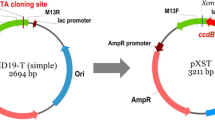Abstract
Conventional digestion and ligation was developed into a novel and efficient approach for directly cloning and sequencing the two ends of bacterial artificial chromosome (BAC) clone inserts. Most BAC vectors have two Not I sites. This end isolation method is based on double digestion of the BAC clone DNA with Not I and any blunt-end restriction enzyme for which there is not a restriction site located within the small fragment (containing the cloning site) between the two Not I sites on the BAC vector. Digestion is followed by ligation of the double-digested mixture with a suitable plasmid vector. The pBeloBAC11 and pBlueScriptII SK vectors were used in the present study. The two ends of the BAC insert can be amplified and sequenced with three specific primers, i.e., amplification of the left end with the pBeloBAC11 LF1 and pBlueScriptII KS primers, and the right end with the pBeloBAC11 RR4 and KS primers. They may be directly recovered by transformation if the end fragments are used as probes. More significantly, this simple strategy generally can be applied to any BAC vector with any cloning site.
Similar content being viewed by others
References
Danesh D, Penuela S, Mudge J, Denny RL, Nordstrom H, Martinez JP and Young ND (1998) A bacterial artificial chromosome library for soybean and identification of clones near a major cyst nematode resistance gene. Theor Appl Genet 96: 196–202.
Gmitter FG, Huang S, Crosby KM, Deng Z and Xiao S (1996) Progress toward isolating the CTV-immunity gene. VIII Proc. Int. Soc. Citriculture, Sun City, South Africa. Printed by Dynamic Ad, Nelspruit. pp 845–848.
Liu YG and Whittier RF (1995) Thermal asymmetric interlaced PCR: automatable amplifi-cation and sequencing of insert end fragments from P1 and YAC clones for chromosome walking. Genomics 25: 674–681.
Riley J, Butler R, Ogilvie D, Finniear R, Jenner D, Powell S, Anand R, Smith JC and Markham AF (1990) A novel, rapid method for the isolation of terminal sequences from yeast artificial chromosome (YAC) clones. Nucleic Acids Res 18: 2887–2890.
Sambrook J, Fritsch EF and Maniatis T (1989) Molecular cloning: a laboratory manual, 2nd ed. Cold Spring Harbor Laboratory Press, New York.
Shizuya H, Birren B, Kim UJ, Mancino V, Slepak T, Tachiiri Y and Simon M (1992) Cloning and stable maintenance of 300-kilobase-pair fragments of human DNA in Escherichia coli using an F-factor-based vector. Proc Natl Acad Sci USA 89: 8794–8797.
Sterky F, Holmberg A, Alexandersson G, Lundeberg J and Uhlen M (1998) Direct sequencing of bacterial artificial chromosome (BACs) and prokaryotic genomes by biotin-capture PCR. J Biotechnology 60: 119–129.
Woo SS, Jiang JM, Gill BS, Paterson AH and Wing RA (1994) Construction and characterization of a bacterial artificial chromosome library of Sorghum bicolor. Nucleic Acids Res 22: 4922–4931.
Author information
Authors and Affiliations
Rights and permissions
About this article
Cite this article
Chen, C., Gmitter, F.G. Direct Cloning and Sequencing of Bacterial Artificial Chromosome (BAC) Insert Ends Based on Double Digestion. Plant Molecular Biology Reporter 17, 231–238 (1999). https://doi.org/10.1023/A:1007699226063
Issue Date:
DOI: https://doi.org/10.1023/A:1007699226063




